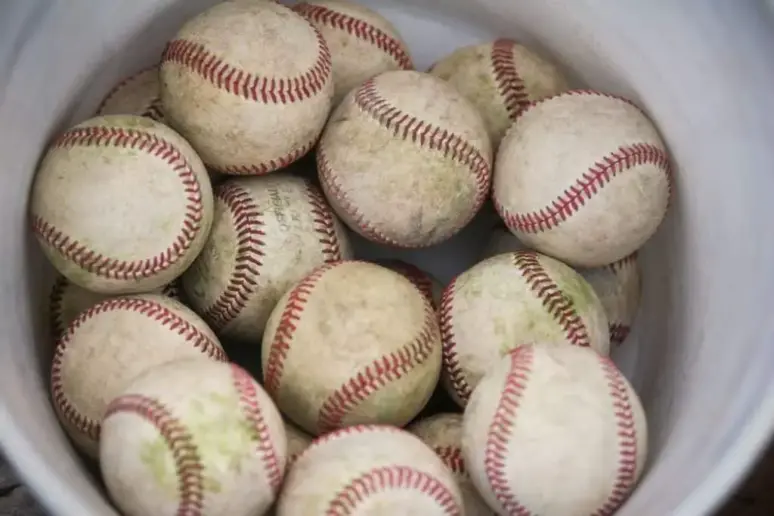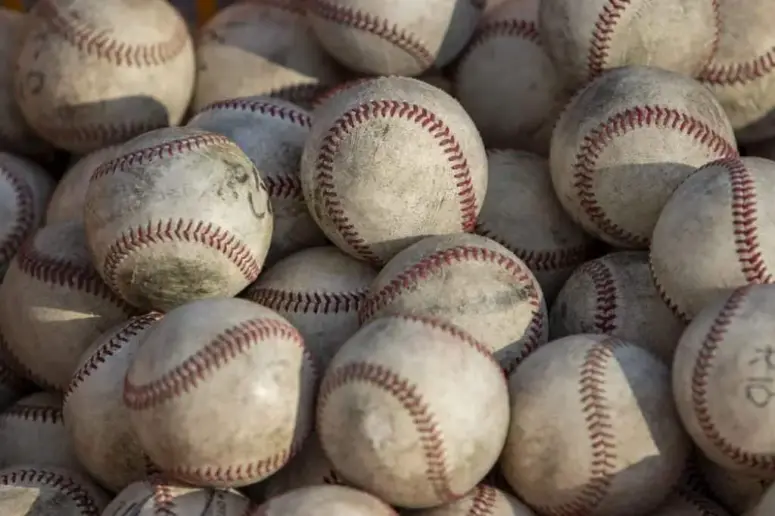Why Do They Change Baseballs When it Hits the Dirt? (Solved!)
The life-long baseball fans take most of what’s going on the field for granted.
However, for outsiders or those new to baseball, a lot of rules and events during the game seem unusual, confusing, or just plain weird.
One of the things confusing the viewer the most is that the catcher frequently gets rid of the ball after the pitch.
After he catches it, the catcher takes a short look at the ball and hands it over to the umpire. The next pitch is thrown with a brand-new baseball.
If you check it out more carefully, you’ll notice that this doesn’t happen every time. The switch only takes place after the ball touches the dirt.
So, why do they change baseballs when it hits the dirt? In the shortest terms, a dirty or scuffed ball gives a pitcher an unfair advantage.
However, this topic deserves a more detailed explanation.
Table of Contents
Why Do They Change Baseballs When it Hits the Dirt?

Of course, changing the ball doesn’t just happen on a pitcher’s whim because he doesn’t like the ball or whatever.
There’s a century-old rule and perfectly logical reasoning behind it.
The catcher gets rid of the ball due to the official MLB rule, enforced by the umpires.
Every time an umpire notices that there’s dirt on the ball or that it’s scuffed, the new ball is introduced.
Unfair Advantage for the Pitchers
A Scuffed ball makes the batter’s job harder, providing the pitcher with an unfair advantage. First of all, hitters can have trouble clearly seeing the ball as it flies their way.
Considering that nowadays pitchers routinely throw 100 mph pitches, it is clear how this puts them in a better position.
With the ball flying that fast, batters have less than a second to react.
Not being able to clearly track the trajectory of the ball not only can mess up their hit but also lead to potentially serious injury.
Dirt can also change the pitch trajectory. Any scuff of the ball changes the way it flies.
Changing the wind resistance and the weight balance of the ball, dirt can cause an unexpected curve or a sudden drop or rise.
And with many talented pitchers today, they certainly know how to use these small advantages. However, this puts hitters in an unfavorable position.
What do the Rules Say about Dirt on the Balls
To preserve the integrity of the game and provide a level playing field for everyone, the league outlawed scuffed or dirty balls.
The official MLB rules deal with it in Section 3.01. It states that intentional discoloring or damaging the ball is not allowed.
This includes rubbing it with soil, rosin, pine tar, sand-paper, or any other foreign substance.
The penalty for breaching this rule is the removal of the offender from the game. The player caught doctoring the ball will be suspended for 10 games.
Rules on Taking the Ball out of Play
As for changing the balls, the rules list three instances when this may happen and when the umpires are required to introduce a new ball to the game.
When the Ball is Hit Out of Play
Home run and foul balls are always replaced with new ones. Rule 4.01(e)(1) states that any ball batted out of the field or into the stands must be replaced.
Even if a fan throws the ball back to the field after a home run, a new ball is still required.
Whenever the Ball is Discolored or Unfit for Use
This case is regulated by Rule 4.01(e)(2) of the MLB rulebook.
This is why you can often see catchers check out the ball and hand it over to the umpire if it’s discolored or dirty.
Whatever the reason may be for the ball to be deemed unfit or discolored, the replacement is mandatory.
This includes cases when the ball hits the dirt.
When Pitchers Request a New Ball
Per Rule 4.01(e)(3) of the MLB rulebook, the umpire can change the ball at the pitcher’s request.
If a pitcher is, for whatever reason, not happy with the ball, he can call a time-out and have an umpire hand him a new one.
With frequent ball replacements, this doesn’t happen very often but still occurs from time to time.
History Behind the Replacement Rules
The MLB introduced the rule which requires the umpire to replace the dirty or scuffed ball after an unfortunate event that happened more than a century ago.
On August 16, 1920, New York Yankees played Cleveland Indians. Ray Chapman was Cleveland’s shortstop, second baseman, and third baseman.
At one point in the game, Chapman was at the bat for Cleveland, while Carl Mays was pitching for the Yankees.
As it was later discovered, Mays soiled the ball using dirt or something similar. Whatever it was, the ball was too “grimy” for Chapman to see it coming.
The ball hit him straight to the head, resulting in a skull fracture and leading to Chapman’s death later that day.
He’s still the only MLB player to die from a game-related injury.
Following Chapman’s death, MLB started to implement the rule requiring umpires to replace dirty or scuffed balls.
What Does MLB Do with Baseballs that Hit the Dirt?

You may be wondering what happens to the dirty balls once the catcher hands them to the umpire to discard them.
As the number of discarded balls over the season is really huge, it doesn’t seem like a good idea to just throw them in the trash.
And, of course, MLB teams don’t do that.
Some of the tossed balls are used for batting practices, however, a fair share of them has a much more interesting destiny.
They get authenticated and sold as game-used memorabilia.
When the ball is deemed unusable after hitting the dirt, it’s taken away by a batboy or tossed to the home dugout.
A team officer in charge of authentication then notes the date of the game, pitch count, and the name of the batter at the time.
Sometimes, he can add even more information.
How to Get a Game-Used Ball
Once authenticated, the balls are labeled and packaged. They get a serial number and are entered into an online database.
Now, they’re ready to be sold to collectors.
Usually, you can buy them at the stadium’s merch store or online the next day or even right after a game.
Sometimes you can even purchase the ball during the game. The same thing happens with broken bats, game-worn jerseys, wristbands, etc.
Truly special game balls are often transferred to New York to be auctioned off to the big collectors. This is the scenario that happens at every MLB park after the game, throughout the season.
How Much Do the Game-Used Balls Cost?
Plain match balls are sold for $20-25. However, balls that were a part of a significant play, go for much higher prices.
I’m talking about balls from a playoff game-winning home run, perfect game, or a certain player’s milestone achievement.
Nowadays, sports memorabilia is a huge and profitable industry. These balls are usually immediately put under strict security.
Some of the balls reach mind-boggling value, being sold for more than a million dollars. Mark McGwire’s 70th home run ball holds the record with $3 million.
How Many Baseballs Are Used in an MLB Season?

During the season, MLB teams go through a staggering number of baseballs.
Between balls that touch the dirt, foul balls, home runs, and players tossing the balls to fans, it’s easy to understand why the numbers are so huge.
It’s estimated that the life span of a baseball is usually two or three pitches. For a standard nine-inning game, the number of balls used can easily go to 120.
With 30 teams in the MLB playing 162 games each, the total number of games in the season is 2430.
And, that’s not counting playoffs, world series, or spring training.
So, if we add it all up, we get to a number of about 900,000 balls used in the MLB during the regular season.
With base percentages increasing, we can expect this number to rise even more. Even now, as things stand, this is one of the biggest expenses MLB faces.
Conclusion
Changing the ball that hits the dirt is something that has been happening in the league for more than a hundred years.
Like most of the baseball rules or practices, it may seem a bit odd, but has perfectly valid reasoning behind it.
Tossing away the dirty or scuffed balls were introduced mostly with the player’s safety in mind. Also, it helps create a level playing field with no players given an unfair advantage.
It may be costly for the league to go through hundreds of thousands of balls every year, but the result is more than worth it.
Thanks to this rule, among other things, injuries that come as a result of the ball hitting the batter, are now an extremely rare occurrence.
In addition, getting rid of dirty balls gives fans a chance to buy them and own a valuable piece of team memorabilia.




